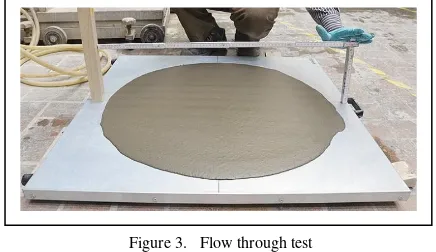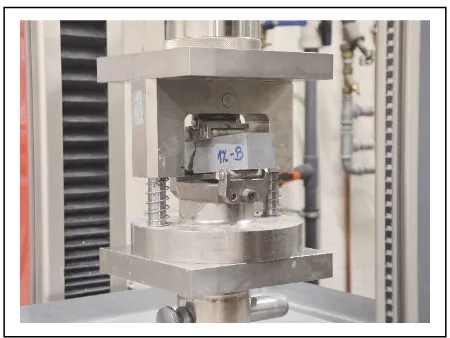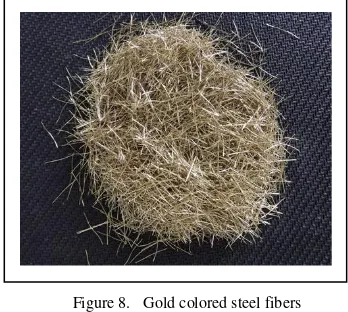http://www.icci-unika.com 44
Properties of Ultra High Performance Concrete
Yuliarti Kusumawardaningsih
1, Rr. M. I. Retno Susilorini
2, Attitou Aboubakr
3 1Civil Engineering Department, Engineering Faculty, Semarang State University (UNNES), Semarang, Indonesia 2
Department of Civil Engineering, Faculty of Engineering, Soegijapranata Catholic University, Semarang, Indonesia 3
Concrete Structures Department, Institute of Structural Engineering (IKI), Kassel University, Kassel, Germany
yuwistk2@gmail.com1, susilorini@unika.ac.id2, attitou_amen@yahoo.com3
Abstract—Concrete has excellent characteristics, such as: high strength, durability, resistance, shape versatility, low maintenance, and low price. However, the current conventional concrete [NSC (Normal Strength Concrete) and HPC (High Performance Concrete)] have not satisfying the demand of constructing structures having remarkable strength, and more varieties in size and shape. The invention of RPC which later on known as UHPC (Ultra High Performance Concrete), gives an advantage in the concrete world. RPC or UHPC shows remarkable enhancements on concrete properties. The superior properties of UHPC have
contribute into a structure’s overall performance and safety,
parallel with providing longer service life, and lower maintenance cost. In order to enrich guidelines and recommendations, investigations of UHPC is significant, in particular for material and structural design needs.
Keywords—concrete, material, properties, RPC, UHPC
I. INTRODUCTION
Concrete is the most widely used material in construction. It is an efficient and a flexible material to used in a variety type of buildings and infrastructures, regards to its excellent characteristic, such as: high strength, durability, resistance, shape versatility, low maintenance, and low price. However, the current available types of concrete either NSC (Normal Strength Concrete) or HPC (High Performance Concrete) could not yet answered the rising demand of structures having remarkable strength, and more varieties in size and shape. These matters, have led to the necessity of utilizing advanced material.
Since the last two decades, a very high strength and ductility material cement composite based named RPC (Reactive Powder Concrete) had been invented. In the beginning year of 1990s, RPC was first investigated by Bouygues. In the year of 1997, the RPC invention was then followed by the successful construction of the first
world’s RPC engineering structure namely the Sherbrooke pedestrian bridge which was built by Ductal® in Sherbrooke, Quebec, Canada [1, 2]. The figure of this bridge is shown in Fig. 1.
RPC which later on is also named as UHPC (Ultra High Performance Concrete), is a natural extension of the conventional concrete (NSC and HPC). UHPC shows a remarkable concrete material which has enhancements on its material properties. When an amount of fiber is added in its composition, UHPC is called as Ultra High Performance Fiber Reinforced Concrete (UHPFRC). The
additional of fiber is believed to increase the material strengths and durability.
The superior characteristics of UHPC have allowed this material to be used in structures which require less weight, greater spans and durability. The enhanced properties of UHPC contribute and improve the structure’s overall performance and safety, provide longer service life, and lower maintenance cost.
However, despite current successful research and applications of UHPC in the field, current guidelines have not yet giving a standard norm because the recommendations is still in premature due to limited literatures. Thus, investigations toward UHPC is significant for its material and structural design needs.
This paper will present a short description of UHPC then is followed by an investigation result of the material properties of UHPC. For clarifying the investigation results, current guidelines and previous research will be adapted. It shall be noted that results of specific experimental works regards on the UHPC properties used in this study were not all being conducted. Values of some material properties are taken by referring to some sources.
Figure 1. The Sherbrooke pedestrian bridge in Sherbooke, Quebec, Canada [3]
II. ULTRA HIGH PERFORMANCE CONCRETE
http://www.icci-unika.com 45 fresh mixture. Another significant aspect is the availability
of a very fine quartz sand instead of ordinary coarse aggregate in the UHPC composition. Which is believed to reduce the heterogeneity between cement matrixes and aggregates[1-6].
An illustration of stress-strain curves comparison among NSC, HPC and RPC (UHPC) is shown in Fig. 2. It can be seen here, that the presence of fibers and confinements significantly enhance the strength of UHPC.
The compressive strength of UHPC can approach a value of exceeding 150 MPa. Current research in Kassel University, mentions that UHPC is able to reach a compressive strength until 250 MPa [7]. In addition of its high compressive strength, UHPC offer multitude enhancements compare to HPC as follows:
UHPC has a higher tensile (over 15 MPa) and flexural (over 50 MPa) strengths.
UHPC has a higher ductility, when an adequate amount of fiber is added in its composition. This provides greater reliability under overload conditions.
UHPC has a higher durability to freeze-thaw cycles, chloride penetration, abrasion resistance and carbonation.
Figure 2. Stress-strain curves comparison of NSC,HPC and RPC [6]
III. INVESTIGATION
Aiming to investigate the material properties of UHPC, a set of material test had been conducted in the Official Material Testing Institute for Construction Industry - AMPA (Amtliche Materialprüfanstalt für das Bauwesen) in Kassel University. The investigation had chosen to use the UHPC having a type of M3Q_210, an UHPC type developed and made by AMPA.
In this study, the M3Q_210 was designed to have a variety of fiber percentages by volume, namely 0%, 1% and 2%. In the composition, cement type of CEM I 52,5R HS-NA made by HOLCIM was used. Zyklos ZK 150 HE, a stationary hydraulic concrete mixture machine having a maximum capacity of 170 L was used to produce the UHPC. Table 1 shows the M3Q_210 mixture composition of this study.
Prior to the testing, the specimens were removed from their moulds one day after casting, and then specimens were left to be cured under room temperature. Specimens were tested under an increasing deformation until failure by using testing machines, such as:
Compression test - using the Toni Technik Compression Testing Machine which has a maximum load of 4000 kN.
Tensile test – using the RBO2000 Tension Testing Machine which has a maximum load of 1.6 MN. Flexural tensile test – using the Zwick Roell Z150
CompressionTesting Machine which has a maximum load of 150 kN.
TABLE I. M3Q_210COMPOSITION
A. Flow through
Flow through test was carried out to determine the flow, consistency, and workability of UHPC. High fluidity of mixture attributes UHPC mortar to flow and give good distribution during casting. The test was conducted before fresh UHPC was placed into its moulds. Fresh UHPC was filled into an upside-down slump cone, then, the slump cone was raised vertically upwards away from the concrete (see the flow through test in Fig. 3)
Figure 3. Flow through test
http://www.icci-unika.com 46 recommendation of UHPFRC [8] which recommends
UHPFRC flow value of 230-270 mm is inapplicable.
B. Compressive strength
In order to determine the compression strength of UHPC, either cylinder or cubic specimens can be used. However, as the compression strength of UHPC obtained using cubic specimens is not a uniaxial strength, converting its value to the cylinder specimen values is necessary. This converting factor is 0.96, as can be seen in Fig. 4 [13].
Figure 4. Relation of cylinder and cubic compressive strengths [13]
In this study UHPC was firstly designed to possess a compressive strength (fcku) after 28 days of ± 200 N/mm2. A variety number of UHPC casted using cylinder and cubic specimens were made, in order to investigate the actual compressive strength of UHPC used. The cylinder specimens have a diameter of 100 mm and a height of 200 mm, while the cubic specimens have a dimension of 100 mm x 100 mm x 100 mm. Towards the test, no capping were applied on both top and bottom surfaces of cylinder specimens. However, both surfaces were cut (grinded) to form flat surfaces. Fig. 5 shows the compressive strength test of this study.
The UHPC compressive strength can be calculated using equation [15]:
(1)
where, fcku = UHPC compressive strength P = maximum load at failure
Ac = cross sectional area of the specimen
Next, it is identified that UHPC used in this study has mean compressive strength of 177.43 MPa (for UHPC contains fiber of 0 vol.-%), 180.70 MPa (for UHPC contains fiber of 1 vol.-%), and 186.47 MPa (for UHPC contains fiber of 2 vol.-%). The fibers have influenced on the UHPC compressive strength. However, these value is less than the design UHPC compressive strength value of 200 MPa (fckud). Specimens of UHPC contains no fiber experienced sudden explosive and brittle failures. While, UHPC specimens contains fibers had rupture failures, which marked the rupture of fibers.
Figure 5. Compressive strength test
C. Tensile strength
In order to determine the UHPC tensile strength, a variety of specimens is used either with or without notches (see Table 2). Direct tensile strength tests on UHPC having no fibers show UHPC tensile strength values of 7-10 MPa.
However, Japan recommendation mentions the value of tensile strength of 5 MPa [8]. While, SETRA/AFGC guidelines of France [11] proposes a direct and flexural tensile strength values of 8 and 8.1 MPa for design values, respectively. In general, the tests have brittle failure and show no falling branch. However, the UHPFRC tensile strength is higher namely 7-15 MPa. The failure behaves ductile, and after its onset cracking, the specimens can have stress crack opening diagram.
Next, Fig. 7a illustrates a typical UHPFRC tensile stress – crack opening diagram. The slope of falling branch can be vary, it depends on the fibers content characteristics. While Fig. 7b illustrates a typical bending tensile stress – crack opening diagram.
In this paper, the tensile strength results of the UHPC which was investigated is not presented; but in separate publication.
D. Flexural tensile strength
http://www.icci-unika.com 47 A number of UHPC prism specimens having a
dimension of 40 mm x 40 mm x 80 mm were tested at their age of ± 28 days, in order to investigate the flexural tensile strength of UHPC used in this study [9, 10]. Specimens were tested with third-point loading to ensure
that forces are applied perpendicular to the specimen’s
face and applied without eccentricity (see Fig. 6).
Then, it is identified that concrete used in this study has a mean concrete flexure strength of 11.63 MPa (for UHPC contains fiber of 0 vol.-%), 13.77 MPa (for UHPC contains fiber of 1 vol.-%), and 14.23 MPa (for UHPC contains fiber of 2 vol.-%).
The fibers have influenced on the UHPC flexural tensile strength. These value is higher than the design value proposed by SETRA/AFGC guidelines of France [11] namely 8.1 MPa. In normal concrete, the values of flexure strength generally is about 10-20% the values of concrete compressive strength [12]. However, in this study the values of flexure strength generally is higher namely about 20-27% the values of UHPC compressive strength (20.64%, 24.88% and 26.55% for each variable of fiber content, respectively).
TABLE2.TYPICAL SPECIMENS FOR UHPCTENSILE STRENGTH TEST [16]
http://www.icci-unika.com 48 design value proposed by the Japan draft recommendation of UHPFRC [8] which is used in calculating the UHPFRC dead load contains 2 vol.-% of fibers, namely 25.5 kN/m3 (162.33 lb/ft3 or 2600.29 kg/m3).
F. Modulus Elasticity
The modulus elasticity of UHPC is higher than NSC and HPC when using identical type of aggregates [7]. For the design purpose, when there is no exact data the value of E = 50000 MPa can be used. However, The Japan draft recommendation of UHPFRC [8] recommends that the SETRA/AFGC guidelines of France [11] proposes UHPC modulus elasticity value of 55 GPa (55000 MPa).
The UHPC modulus elasticity can be calculated using following equations [13].
Next, it is identified that the UHPC has mean modulus elasticity of 49290.97 MPa(for UHPC contains fiber of 0 vol.-%), 50232.75 MPa (for UHPC contains fiber of 1 vol.-%), and 49949.08 MPa (for UHPC contains fiber of 2 vol.-%). These value are close to the first assigned modulus elasticity value of UHPC, namely 50000 MPa.
G. Fibers
In this study, gold colored steel fibers having a length of 10 mm and a diameter of 0.2 mm was used in the UHPC mixture (see Fig. 8). The properties of fibers is gained from its factory as following: the fibers has density of 7.85 kg/ dm3 or 7850 kg/m3, tensile strength of 1250 N/mm2, and modulus elasticity of 200000 MPa.
Figure 8. Gold colored steel fibers
The choice of the fibers used, has taken into account
the fibers’ optimum length which should be in range of 8 -16 mm, and the best mean diameter used should be in range of 0.1-0.2 mm. The Japan recommendation mentions that the standard fibers used should be 10-20 mm in length and 0.1-0.25 in diameter having fibers tensile strength of 2x103 MPa or more, and 2% volume in fraction is used. These considerations are taken in order to achieve the reinforcement effect target, otherwise the fibers will not spread homogeneously in the UHPC mixture [8].
H. Bond interaction
A bond interaction between the surface of NSC and UHPC had been investigated in a separate study. The shear stress value regards on the bond interaction is taken from the push-out test of a doctoral colleague’s research at Kassel University, which results in the range value of 4.3-6.2 N/mm2 [14].
I. Poisson ratio
The poison ratio represents the stress direction ratio of lateral to longitudinal strains. The poison ratio of UHPFRC having fine and coarse aggregates is 0.12 and 0.18, respectively [13]. In the range of linear elastic, the UHPC poison ratio is in the value between 0.5 and 0.22 [16].
The Japan draft recommendation of UHPFRC [8] and SETRA/AFGC guidelines of France [11] proposes that the UHPC poison ratio can be set to 0.2 in the range of linear elastic.
J. Shrinkage
http://www.icci-unika.com 49 shrinkage during the stage of initial setting. Without heat
curing the UHPC shrinkage increases with a total shrinkage of 550 x 10-6 m/m [8, 11].
Figure 9. Development shrinkage in UHPFR since its casting [8]
K. Unit weight
The Japan draft recommendation of UHPFRC [8] recommends that a unit weight of 25.5 kN/m3 can be used in the calculation of UHPFRC dead load, wherein the UHPFRC contains 2 vol.-% of fibers.
L. Viscosity
Due to the UHPC high viscosity, air bubbles may stay on the UHPC surface. 3-5% air may entrapped creating bubbles during the UHPC mixing and casting. In order to remove these bubbles lightly tipping on the UHPC formwork surface can be done [8].
M. Other properties
UHPC has a fracture energy (GFu) of 59.04 Nm/m2 [13].
IV. CONCLUSION
This paper has presented a brief introduction about UHPC, also has introduced its first application in a bridge structure located in Canada. An investigation about a type of UHPC regards of its material properties also reported. In addition, values of some properties which was not investigated in the laboratory are also reported by citing from other sources and references.
ACKNOWLEDGMENT
The work described in this paper was conducted by Yuliarti Kusumawardaningsih as a part of her Doctoral study at Kassel University in Germany, under the supervision of Prof. Dr.-Ing. Ekkehard Fehling. The first author gratefully acknowledges all financial assistances during her study at Kassel University which had been provided by: 1) Indonesian Directorate General of Higher Education, 2) Semarang State University, Indonesia, 3) Chair of Concrete Structures Department (Institute of Structural Engineering, IKI) at Kassel University, and 4) Kassel University. The assistance of colleagues, technical staffs and students who participated in the study, are also being acknowledged. All authors thank the Soegijapranata Catholic University for the publication of this paper.
REFERENCES
[1] P. Richard and M. Cheyrezy, “Composition of Reactive Powder Concretes”, Cement and Concrete Research, Vol. 25, No. 7, 1995, pp. 1501-1511.
[2] P.Y. Blais, M. Couture, “Precast, Prestressed Pedestrian Bridge: World’s First Reactive Powder Concrete Structure”, PCI Journal, 1999.
[3] Ductal, “Sherbrooke Pedestrian Bridge, Quebec, Canada”, accessed on 23/02/2015, International Symposium on Ultra High Performance Concrete, Kassel, Germany, 2004.
[5] P. Buitelaar, “Heavy Reinforced Ultra High Performance Concrete”, Proceedings of the International Symposium on Ultra High Performance Concrete, Kassel, Germany, 2004.
[6] E. Dallaire, P.C. Aitcin, and M. Lachemi, “High Performance Powder”, Civil Engineering, ABI/INFORM Global, 1998, pp.48. [7] M. Ismail, “Behavior of UHPC Structural Members Subjected to
Pure Torsion”, Dissertation, Faculty of Civil Engineering, Kassel University, Germany, 2015.
[8] JSCE Guidelines for Concrete No. 9: “Recommendations for Design and Construction of Ultra High Strength Fiber Reinforced Concrete Structures (Draft)”, Research of Ultra High Strength Fiber Reinforced Concrete Japan Society of Civil Engineers (JSCE), 2006.
[9] AS1012.11: “Determination of the Modulus of Rupture”, Australian Standards, 2000.
[10] DIN EN 196-1: “Prüfverfahren für Zement – Teil 1: Bestimmung der Festigkeit ”, Normenausschuss Bauwesen (NABau) im DIN Deutsches Institut für Normung e.V., Berlin, Mai 2005.
[11] Association Française de Génie Civil (AFGC)/Service d'études techniques des routes et autoroutes (SETRA): ”Bétons fibrés à ultra-hautes performances“, Recommandations provisoires, Janvier 2002.
[12] NRMCA: “Concrete in Practice: What, Why and How”, National Ready Mixed Concrete Association, USA, 2000.
[13] T. Leutbecher, “Chapter 4: Material Properties of UHPC (Draft)”, Kassel University, Germany, 2011.
[14] A. Majed, “Verstärkungen von Stahlbetonträgen unter Nutzung ultrahochfesten Betons (UHPC)”, 53. Forschungskolloquium, Institut für konstruktiven Ingenieurbau der Universität Kassel, Deutschland, 9-10 Oktober 2012.
[15] BS 12390-3: “Compressive Strength of Test Specimens”, British Standard Institution, 2002.
![Figure 1. The Sherbrooke pedestrian bridge in Sherbooke, Quebec, Canada [3]](https://thumb-ap.123doks.com/thumbv2/123dok/4051816.1995236/1.595.307.537.503.667/figure-the-sherbrooke-pedestrian-bridge-sherbooke-quebec-canada.webp)


![TABLE 2. TYPICAL SPECIMENS FOR UHPC TENSILE STRENGTH TEST [16]](https://thumb-ap.123doks.com/thumbv2/123dok/4051816.1995236/4.595.61.537.257.728/table-typical-specimens-uhpc-tensile-strength-test.webp)

![Figure 9. Development shrinkage in UHPFR since its casting [8]](https://thumb-ap.123doks.com/thumbv2/123dok/4051816.1995236/6.595.60.293.128.250/figure-development-shrinkage-uhpfr-casting.webp)